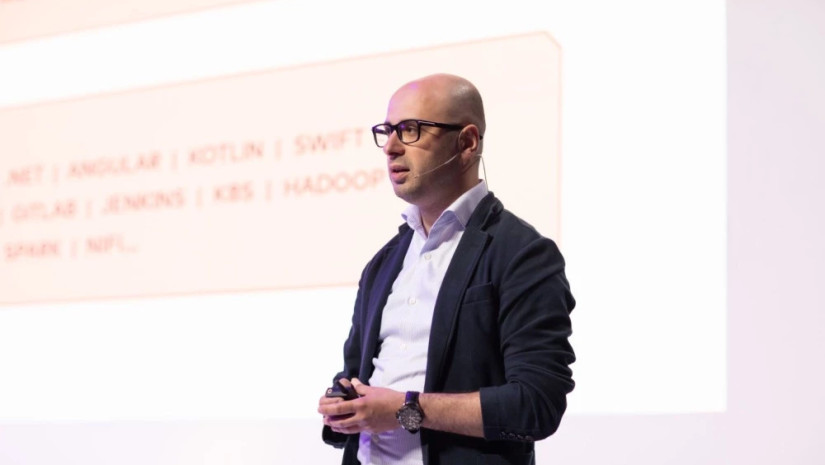Bank of Georgia is an important and leading universal bank in Georgia. The Bank is a leader in the payments business and financial mobile application, with strong retail and corporate banking franchises. In line with its digital strategy, the bank focuses on expanding technological and advanced data analytics capabilities to offer customers more personalised solutions and seamless experiences.
The volume of payment transactions executed through BOG’s offline and online terminals was up 55.7% y-o-y in the first quarter of 2023. Bank of Georgia is a digital banking leader in Georgia, serving more than 1.6 million monthly active retail customers and more than 83 thousand monthly active business clients.
Read below how bank of Georgia joined the digitization process and implemented full observability.
About digitization, influence and inevitable changes.
Vazha Mantua — Deputy CIO, IT Operations.
Digitisation in Bank of Georgia
The heavy digitization covered companies worldwide alongside the COVID pandemic, but we started the digital transformation much earlier.
Our main challenges are scalability, high performance, security, availability, and uncomplicated business processes. When a technology staff increases three or four times, it can be challenging for the service quality as it mostly depends on the staff. That's why we create exciting onboarding processes, including mentorship, code review and teamwork to keep up the service quality.
We had standard waterfall processes, but then we shifted to agile. We started using new KPIs — technology KPI which are measurable. In addition, our company's feedback culture is growing as it is crucial to listen to the employees and try to fix all the issues. A happy employee is a vital factor for success.
Our platforms have become more complicated, and the number of our clients has increased dramatically. It means that we should have flexible and modern architecture, microservices, and lightweight processes, which help us to achieve straightforward scalability.
What moves us to changes
Average companies adapt to customer behavior, while progressive ones can influence it themselves and set trends. And I believe that Bank of Georgia belongs to the second type. At the same time, our customers move us to modifications when using our digital platforms.
We have started using microservice architecture, which is very easy and has simple scalability. Besides, such architecture will help us with cloud perspective: we've announced that in four years, all of our platforms will run in the public cloud — AWS, Azure, Oracle and Google cloud.
The shift to microservices led to branching and increased infrastructure. Consequently, companies must enable full observability to control scaling, changing processes, and architecture. Otherwise, the weight of problems can crush the company when moving to microservices, the cloud, or wherever. Application Performance Monitoring (APM) constantly checks the "health" of processes and infrastructure, the impact of changes on the user, and the operation of services. As a result, full observability of the infrastructure simplifies specialists' work and accelerates the IT transformation of all processes in parallel.
How to choose an APM solution
When searching for any new technical solution, we usually use two approaches: inner search and advice from our partners.
We have a specific architecture team inside the IT organization for inner search. They research to find technical solutions for various tasks and make the first estimation. Sometimes we choose the solution based on our local partners' advice.
As I said, our bank's customers have grown significantly, so our app should run like clockwork, without delays or interruptions. It isn't easy to achieve this without monitoring. When a problem arises, you need to figure out exactly where to look for it. It takes a lot of time to find a malfunction manually. As a result, the application stops its work, the client cannot complete a transaction and goes to your competitors.
So, we realized that clear visibility of interactions is the key to improving the application's functioning and the user experience. Therefore, we actively started to look for monitoring solutions. In our case, there were three main selection criteria: price, quality and compliance with technical requirements, such as completeness of tasks, usability and ease of implementation.
So we decided to try.
In our case, Dynatrace matched all the requests and tasks. We highly appreciate the platform’s technical capabilities, scorecard perspective and the cost. As a rule, the best solutions on the market are always expensive. However, in practice, we realised that the solution perfectly fits our budget, and there is no need to compromise in the search. Besides, Dynatrace has excellent flexibility in working with customers and optimizing costs, which is crucial for us.
About the solution implementation and technical issues.
Davit Lapiashvili — Head of Mobile and Web Development Unit
The rise of Dynatrace: implementation matters
In 2017, we created a new mobile application for our users. It was successful: when we migrated from the old application to the new one, we had around 90,000 installations. However, this application gave us new challenges because we were unprepared for such a load and other issues. We were troubleshooting manually, analyzing and aggregating some data to understand which services have problems.
Our new target was to keep the customers satisfied with a mobile app, which was the number one priority. At that point, we involved Dynatrace. First, we used it precisely for our mobile application back end (Java).
For now, Dynatrace serves as the monitoring and troubleshooting tool which also measures SLA. At the same time, we have many KPI charts and graphs, small platforms or non-mission-critical processes. Open-source solutions, such as Prometheus, are suitable for them.
How we deal with problems detection
Currently, we have two types of detection. First – when clients do not know the problem exists, Dynatrace shows something is abnormal. Then, we'll react promptly, which is the most considerable benefit.
Second – when we miss something or some external factors appear (for example, a new vendor change). It also creates some fluctuations in our system and often affects all infrastructure. Dynatrace allows us to detect this issue in several minutes and fix it before larger-scale infrastructure is involved and something severe happens.
When everything goes down simultaneously, it's still beneficial to use Dynatrace because it helps pinpoint where the problem is and react quickly. All the issues in your infrastructure are sorted by time, but you can see more details by clicking one specific program.
What result we got
When we started working with Dynatrace, we explored some issues we have yet to encounter. For example, we analysed new paths, some exceptions and other traces. And we created new alerts, which gave us more transparency for monitoring.
Before Dynatrace, our customers complained about system failures and severe impacts every now and again. Now we get instant alerts to understand where the problem is. The latest customer satisfaction scores show a significant increase.
Now we are measuring downtimes on our side for every system, and Dynatrace is an easy tool to understand and react to the issue. It helps us identify concerns even the customer cannot see and, consequently, decrease response time, find the root cause of the problem, and fix it.
Conclusions
From our experience, monitoring every single application with Dynatrace is essential if you want to keep your application at a top-level performance. The monitoring tool has all the charts. We strongly advise you to work with them as much as possible because this planning process helps you understand the capabilities and boundaries.
Dynatrace is not just an APM, but an observability solution, and now we are studying all the capabilities of Dynatrace, such as user monitoring, AppSec, monitoring of cloud environments, etc. In the future, we may extend our subscription.
Small companies don't have such a possibility to analyse software deeply. Therefore, we want to be an example of a company that has improved all processes and can guarantee the stable operation of programs thanks to the monitoring platform.















